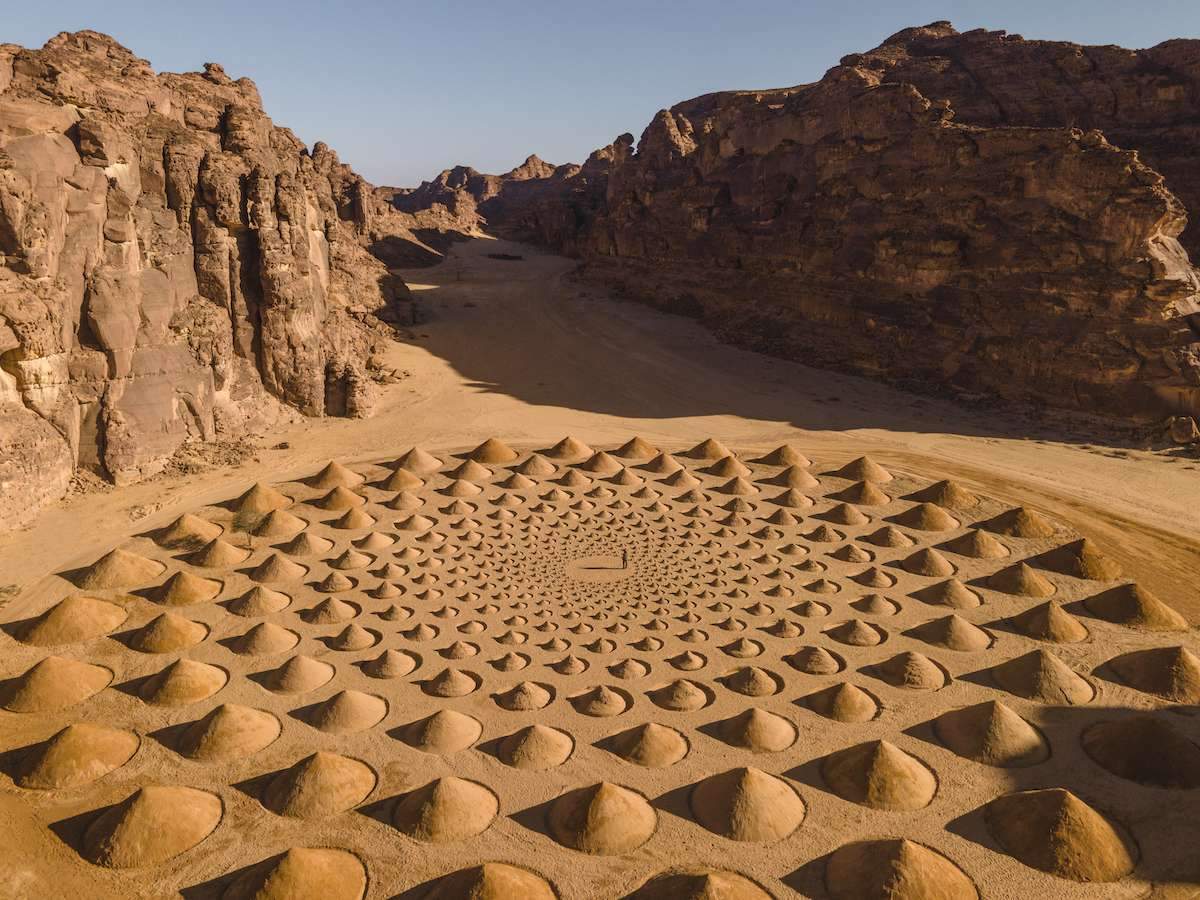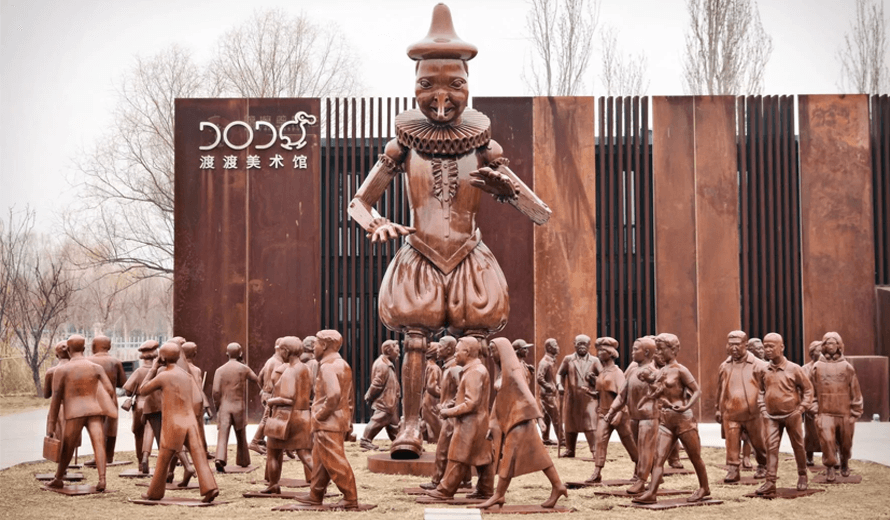When art talks to the desert in Desert X AlUla
When art talks to the desert in Desert X AlUla,
After a two-year hiatus due to the COVID-19 pandemic,
Desert X AlUla is back, the international art fair that showcases great works with stunning AlUla backdrops.
The AlUla desert, which has been attracting people and civilizations for more than 200,000 years,
has drawn 364 concentric circles of sandy hills centered within the picturesque rock formations of AlUla.

When art talks to the desert in Desert X AlUla
The circle of sand hills was drawn by American artist Jim Dennevan, titled The Corner of Comfort,
and is one of the first and largest works visitors will see when they attend the second edition of Desert X AlUla,
which opened on February 11 and runs through March 30.
Heaps of sand gather and move from largest to smallest,
in an amazing and surreal experience that makes one wonder if he is really on planet Earth or perhaps in an alternate, distant reality.
And this was exactly Denevan’s goal, shaping the visitor’s experience in the desert, like many sandcastles.
Denevan’s work is one of 15 works now on display at Desert X AlUla,
the site’s massive contemporary exhibition of desert art, which launched in AlUla in early 2020.
Held for the first time in California’s Coachella Valley in 2017,
the event is about creating art in dialogue with the land that also stimulates intercultural dialogue and the study of relevant topical issues.
The event was organized for this year, to be free and open to all,
in the light of the vision of the curators “Rima Fadda” and “Raneem Farsi” and the founding artistic director of Desert X Neville Wakefield.

When art talks to the desert in Desert X AlUla
For the event, artists from all over the world, the United States, Saudi Arabia, the United Arab Emirates and Ghana,
came forward to create works without any guidance from the organisers,
but instilled in the ideas of literature, nature, history and culture rooted in the desert setting in which they will be set.
The event was organized under the motto ‘Mirage’.
Concepts of mirages and desert oases have always been associated with ideas of survival, perseverance, desire and wealth.
The oasis relates to ideas of finding prosperity or paradise, while the mirage is a universal symbol of the mysteries of fantasy and reality.
It also implies the incomprehensible beauty and abundance of nature at its most disadvantaged state,
the desert, and the obsessive desire of humankind to conquer and control it.
The desert is interesting, because it is a heterogeneous space, and cannot be categorized under one theme.
Through their work, the artists have addressed issues of human progress, migration, ancient history, and most importantly, climate change.
For example, Canadian artist Stephanie Deomer, whose artwork bears the name “Under the Same Sun”, has created an underground greenhouse that works at the intersection of nature and technology.

Visitors can walk from the desert down to Diomer’s greenhouse, as if they were going to an underground shelter but with a sunroof.
Solar energy is feeding live from the outside on the plants encased in a glass jar inside,
and creating this artificial light, mimicking what you see outside to nurture and grow plants, has created a completely self-sustaining system.
When art talks to the desert in Desert X AlUla
British artist Shezad Daoud, whose work is titled Coral Alchemy, decided to mix the uses of ancient and modern environment.
Hundreds of years ago, the rock formations that we see now were all under water.
The two shapes designed by David, are coral-like sculptures.
One unmissable on a large sandy road and the other high within the rock formation as if in camouflage,
as they explore the geological relationship between the desert floor and the nearby Red Sea.
The surfaces of the works are sensitive to temperature, and reflect the effects of the sun as it changes color in certain parts,
as a way of reflecting the outcome of climate change and humanity’s struggle to find sustainable solutions.
Notable pieces also included Ghanaian artist Serge Atakoy Kloty’s “Gold Falls,” a vibrant work of yellow tapestry.
The work is made from square parts of yellow water cans found throughout Africa,
and which the artist has long used to discuss issues related to water scarcity and migration in Africa.
Africans use yellow jerry cans to transport cooking oil from the West, and after using the oil, they use it to store water.
Smaller works by Sheikha Al Mazrou and Zainab Al Hashimi, both from the United Arab Emirates,
also collaborated roughly with the surrounding areas, with colors and shapes similar to the surrounding rock formations.
In Al-Hashemi’s work, Camouflage 2.0, discarded camel skins are used on an abstract geometric basis,
resembling those found in the landscapes of AlUla.

Al-Mazrou’ book, “Void Physicometry”, presents several inflated steel structures fixed in the void of rocks that one must search for to locate them.
The participating Saudi artists – Shadia Alem, Abdullah Al-Othman, Sultan Bin Fahd, Ayman Zidani and Dana Awartani –
also thoroughly explored the landscapes of AlUla and its ancient history through their art.
When art talks to the desert in Desert X AlUla
The world of twinkling origami sculpture “I saw a thousand stars and one fell to the sky” looks like a giant gem that fell from the sky, adorning the desert landscape.
The Ibn Fahd al-Tiny structure, made with the help of the local community,
in the form of a desert kite that one passes through until one reaches a circular open-air room,
with a large glass jar pointing to the sky, can be found throughout the Arabian Desert.
Archaeologists are still unsure whether the ancient structures were tombs or traps where Bedouins captured animals.
Zidani’s performance piece can be reached by climbing a rocky mountain following the yellow and green ropes,
and upon reaching the rocky cave at the top, visitors hear a recitation of Arabic words for desert plants with the background sounds of the surrounding desert landscape.
The experience is haunting and meditative,
as the sound of the visitor’s footsteps on the rocks adds to the diverse array of sounds that seem to harmonize so organically.
A viewing trip at Desert X AlUla adds to the experience of viewing art and a state of being in nature.
One feels the scale of the desert landscape, the sandy winds and the air,
recalling the force needed to inhabit or traverse these habitats for extended periods of time.
The film “The Geography of Hope” by Al-Othman reflects the experience of seeing a mirage in the desert after a long and arduous journey.
It is a long strip of shiny steel in the shape of a water body that reflects the surrounding landscape.






